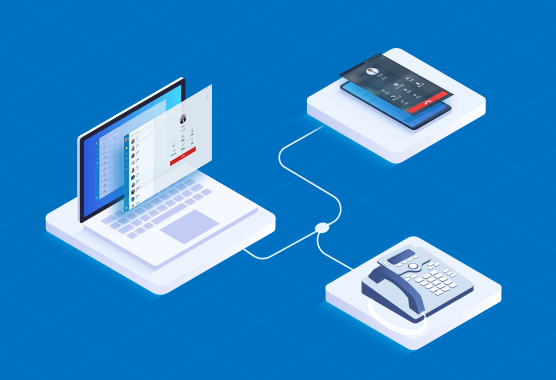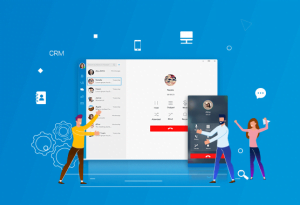

Before cloud telephony and VoIP became mainstream, businesses relied on PBX systems to manage their internal and external calls. Even today, a PBX Phone System remains a key part of many organisations’ communication strategies, whether it’s hosted on-site or operated through the cloud.
PBX stands for Private Branch Exchange. A PBX system is a private telephone network used within a company. Employees can communicate internally (within the company) and externally (with customers) using different communication channels like VoIP, ISDN, or even traditional analogue lines.
Rather than every employee needing a separate direct line to the public phone network, a PBX allows the company to share a set of external lines among all staff.
Traditional PBX systems used to require expensive hardware, wiring, and maintenance, typically housed in a “PBX room” within the office.
Understanding the different types of PBX systems helps businesses choose a solution that matches their needs, budget, and scalability plans.
A Traditional PBX, also called a legacy PBX, consists of physical hardware housed within the company’s premises. These systems use standard copper telephone lines (PSTN) and require manual installation and maintenance by an in-house IT team or an external vendor. They are ideal for companies that want full control over their phone systems and have the resources to maintain them. However, scaling these systems can be expensive, as each new user often requires new wiring and hardware upgrades.
Typical users: Large corporations, government offices, and organisations needing ultra-high reliability with no dependence on the internet.
Advantages:
Challenges:
An IP PBX modernises the traditional PBX by using the internet (Internet Protocol) to route calls internally and externally. It still involves on-site hardware but leverages the flexibility of VoIP technology. IP PBX systems allow integration with data networks, CRM platforms, and mobile apps.
Typical users: SMEs and mid-sized companies upgrading from legacy systems who want more features and flexibility.
Advantages:
Challenges:
A Hosted PBX, also known as Cloud PBX, removes the need for onsite PBX hardware entirely. The service provider manages the PBX servers and call routing infrastructure offsite. Businesses connect to their PBX system via the internet using IP phones, softphones, or mobile apps.
Typical users: Startups, SMEs, and fast-growing companies that prioritise flexibility, cost efficiency, and remote work capabilities.
Advantages:
Challenges:
A PBX phone system brings together the best of professionalism, efficiency, and flexibility—making it a critical asset for businesses of all sizes. Let’s dive deeper into the core benefits.
A PBX ensures that incoming calls are handled smoothly and professionally. Features like auto-attendant menus, custom greetings, call transfers, voicemail, and hunt groups allow even small businesses to present themselves with the polish of a large corporation. Missed calls and customer frustration are greatly reduced.
Moreover, PBX systems allow businesses to set up call routing based on time-of-day, department, or employee availability, creating an optimal customer experience every time.
Rather than installing individual telephone lines for each employee, businesses use fewer external lines that are intelligently shared across users. This dramatically lowers line rental and call costs.
In addition, hosted PBX or cloud PBX models eliminate expensive hardware investments and ongoing maintenance fees. Predictable monthly subscriptions replace the uncertainty of traditional phone system expenditures.
For businesses making frequent international calls, VoIP-enabled PBX systems offer particularly significant savings.
As your business grows, your PBX phone system can grow with it. Adding new users or extensions typically requires only a few clicks in a dashboard or a call to your service provider, rather than rewiring offices or purchasing expensive additional hardware.
Hosted PBX solutions especially allow businesses to scale up during peak seasons and downsize during quieter periods without penalty. This elasticity ensures you only pay for what you need.
Traditional on-premises PBX systems are known for their robustness and uptime. Even cloud PBX solutions now offer high-availability options, redundancy across multiple servers, and built-in disaster recovery features.
With a reliable PBX system, businesses enjoy uninterrupted communication, which is crucial for customer service, internal collaboration, and overall productivity.
Modern PBX platforms provide detailed reporting dashboards. Managers can track call volume, call durations, missed calls, peak times, and employee responsiveness. This data helps optimise staffing, refine customer service strategies, and improve operational efficiency.
Whether you’re a growing startup or an established enterprise, a PBX phone system offers a proven, versatile solution to manage business communication smartly and effectively.
In Singapore, modern SMEs and enterprises are moving towards IP PBX and Cloud PBX systems to enhance flexibility while keeping professional call handling features intact. Providers like Upon SG deliver Yeastar-based Cloud PBX services that cater to growing and dynamic businesses.
Absolutely. While technology has evolved, PBX remains the backbone of structured business communication, especially when integrated with VoIP.
PBX is the private network that manages calls internally, while VoIP is the method of transmitting those calls over the internet.
Yes. Many businesses transition by porting existing numbers and using IP phones or softphones connected to a hosted service.
Cloud PBX systems use encryption, secure data centres, and constant monitoring to ensure high levels of security.
A PBX Phone System gives businesses the control, professionalism, and scalability they need to handle communication effectively. Whether you’re upgrading from an old system or starting fresh with cloud technology, PBX remains at the heart of efficient business communication.
Talk to Upon SG today to find a PBX solution that fits your company’s size, goals, and future growth.





By now, you have probably heard about all the fantastic

Softphones bring a wealth of advantages to business communication, such

Please be informed that our office will be closed from

Please be informed that our office will be closed from
